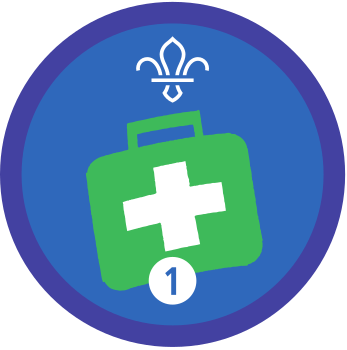
Mini medics
You’ll need
- Sheets
- Face paint (in a variety of colours, including red)
- Gloves (optional)
- Bandages or plasters (optional)
Before you begin
- Download and print out enough copies of the St John Ambulance emergency first aid advice poster so that everyone can see them.
Mini medics training
- The person leading the activity should find an adult to help them with role-playing some accidents. Together they’ll show how to help someone who’s bleeding and someone who’s unconscious.
- In the bleeding scenario, the adult has fallen over and cut their leg on glass. They should use face paint to draw a small cut and act visibly upset at their accident. The person leading the activity should follow the St John Ambulance guide sheet to help and explain to the whole group what they’re doing.
- Move onto the unconscious scenario: the adult helper should lie still on the ground and the person leading the activity should again follow the St John Ambulance guide sheet to help them and explain to the whole group what they’re doing.
Put it into practice
- The person leading the activity should split everyone into small groups, each with an adult helper and some St John Ambulance guide sheets.
- Each group should sit in a circle, leaving an arm’s length of space between each other.
- One person in each group should be the medic and another should be the patient. The medic should then leave the room or area, so they can’t see or hear the rest of their group.
- Each group should decide what sort of injury the patient will have (a small cut, larger cut, or of consciousness) and perhaps create a fake wound using face paints.
- The patient should act as though they’re injured or, if they’re pretending to be unconscious, lie down still on the ground.
- Once the groups are ready, they should call the medics back in. The medics should assess what has happened and start to treat them – remembering to use gloves and bandages or plasters if needed.
- Repeat the process, so everyone gets the chance to be a medic, and use their skills.
Reflection
This activity helped everyone to learn what to do in some emergency scenarios and to improve their first aid skills. Everyone should feel proud about completing their mini medic training and feel more confident about helping someone who’s injured. Can everyone remember the steps to take when someone is unconscious or bleeding, without looking at the St John Ambulance guide sheets?
While it’s important to call for help from an adult or medical professional in an emergency, everyone should know they can still help someone who is injured. Reassuring a patient is often as important as the medical treatment they receive. Can anyone remember how they were comforted when they were unwell? What comforting words would they like to hear if they were injured?
Safety
All activities must be safely managed. You must complete a thorough risk assessment and take appropriate steps to reduce risk. Use the safety checklist to help you plan and risk assess your activity. Always get approval for the activity, and have suitable supervision and an InTouch process.
- Contact games and activities
Make sure everyone understands what contact is acceptable, and monitor contact throughout the activity.
When demonstrating how to treat bleeding and unconsciousness, go into as much or as little detail as the group needs. They might not need to know how to put someone in recovery position, but they could learn how to call for help.
Anyone who is uncomfortable with touching other people can use toys or action figures to demonstrate or explain what they’d do verbally. If someone is uncomfortable being touched themselves, they don’t have to play the role of the patient.
All Scout activities should be inclusive and accessible.
Role play what happened before the accident and combine this with making a call to the emergency services as part of the Beavers Safety Activity Badge or Cubs Personal Safety Activity Badge.
Young people can decide on the injury they wish to play out. Ask Young Leaders to get involved as injured people for the mini medics.
